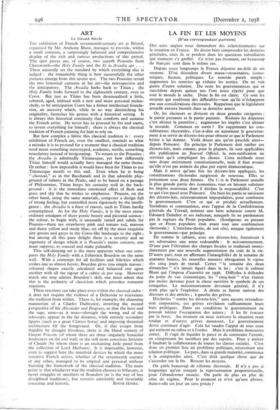ART
Le Grand Steele
THE exhibition of French seventeenth-century art at Bristol, organised by Mr. Anthony Blunt, manages to provide, within a small compass, a surprisingly balanced and comprehensive display of the rich and various productions of this period. The spot pieces are, of course, two superb Poussins from Chatsworth—the Holy Family and the Et in Arcadia ego . . . These naturally set the standard by which everything else is judged : the remarkable thing is how successfully the other pictures emerge from this severe test. The two Poussins reveal the two historical currents in his art—the retrospective and the anticipatory. The Arcadia harks back to Titian ; the Holy Family looks forward to the eighteenth century, even to Corot. But just as Titian has been desensualised a little, sobered, aged, imbued with a new and more personal melan- choly, so by anticipation Corot has a firmer intellectual founda- tion, an ancestry which, while in no way diminishing his originality, furnishes his genius with a historical setting. It is always this historical continuity that comforts and sustains the -French artist. He never has to proceed by fits and starts, to invent everything for himself ; there is always the classical tradition of French painting for him to rely on.
But how complex a fabric this classical tradition is : every exhibition of. French art, even the smallest, reminds us what a mistake it is to pretend for a moment that a classical tradition need mean something stereotyped, academic, sterile, something retardatory instead of invigorating. To return to the Poussins : the Arcadia is admittedly Titianesque, yet how differently Titian himself would actually have managed the same theme. Or rather : how impossible it would have been for Titian to use Titianesque motifs to this end. Even when he is being " classical," as in the-Bacchanals and in that adorable play- ground of infants in the Prado, said to be based on a passage .of Philostratus, Titian keeps his curiosity well in the back- ground : it is the immediate emotional effect of flesh and grass and sky that he wishes to emphasise. Poussin, on the other hand, using the same materials, composes a design full of strong feeling, but controlled more rigorously by the intelli- gence : the Arcadia is a feast of reason, such as Titian hardly contemplated. As for the Holy Family, it is the most extra- ordinary amalgam of sheer poetic beauty and pictorial science : the colour, to begin with, is unusually varied and subtle for Poussin—there are strawberry pink and tomato red, maroon and dusty yellow and steely blue, set off by the most exquisite airy greens and greys in the Corot-like landscape to the right ; but among all this pure delight there is a severity and an ingenuity of design which it is Poussin's entire concern, one must suppose, to conceal and make palatable.
This self-denying art is the more apparent when one com- pares the Holy Family with a S ebastien Bourdon on the same wall. With a contempt for all facilities and felicities which strikes one as almost heroic, Bourdon gives you simple masses : coloured shapes exactly calculated and balanced one upon another with all the rigour of a cubist de pur sang. However much one may admire Bourdon's skill, one must admit that this is the pedantry of classicism which provokes romantic reactions.
These reactions can take place even within the classical cadre : it does not require the violence of a Delacroix to rejuvenate the tradition from within. There is, for example, the charming mannerism of a Charles Dufresnoy, inverting the mental perspective of his Alexander and Diogenes, so that the hero and the sage, seen—as it were—through the wrong end of the telescope, appear in the far distance, while entirely secondary figures (such as a great Chirico horse) and imposing theatrical architecture fill the foreground. Or, if this escape from frigidity be thought frivolous, there is the bland scenery of Gaspar Poussin (of whom there are three singularly beautiful .landscapes on the end wall) or the still more conscious lyricism of Claude (by whom there is an enchanting little panel from the collection of Lord Methuen). It is impossible, however, even to suggest here the manifold devices by which the more sensitive French artists, whether of the seventeenth century or any other, managed to be original and personal without bursting the framework of the classical tradition. The main point is that whichever way the tradition chooses to bifurcate, it never straggles or smothers or flounders (as is the way of less disciplined traditions), but remains admirably and invariably


























































 Previous page
Previous page